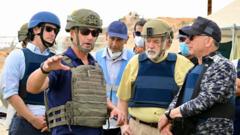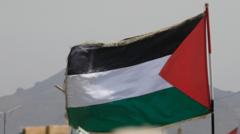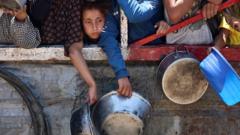Satellite imagery has unveiled significant damage to Iran's Natanz and Isfahan nuclear sites, as well as missile facilities near Tabriz and Kermanshah. Analysts highlight the implications for Iran's uranium enrichment capabilities.
Damage Assessment of Iranian Nuclear and Missile Sites Through Satellite Imagery

Damage Assessment of Iranian Nuclear and Missile Sites Through Satellite Imagery
Recent satellite images reveal the destruction at key Iranian nuclear facilities and military sites following targeted strikes.
Recent satellite analyses have uncovered alarming levels of destruction at essential Iranian nuclear installations and military complexes, raising concerns about the country's nuclear ambitions. Imagery provided to BBC Verify from several satellite providers reveals extensive damage, particularly at the Natanz nuclear site and a missile installation in Tabriz, following a series of military strikes.
At Natanz, Maxar's optical imagery illustrates marked destruction to the pilot fuel enrichment plant and a critical electrical substation. The International Atomic Energy Agency (IAEA) reported to the UN Security Council that the upper structure of the uranium enrichment facility had been reduced to ruins, disrupting Iran's ability to produce uranium enriched up to 60% U-235, a crucial element for both power generation and weaponry. Footage of the aftermath captured smoke billowing from the site, indicating the magnitude of the strike.
Military experts, including Justin Bronk from the Royal United Services Institute, suggested that the type of explosions observed aligns with the use of penetrating bombs, akin to Israel's tactics in earlier operations against fortified facilities. Despite these reports, IAEA officials noted no evidence of an assault on the deeper underground components of the enrichment facilities.
Further inspection of the Isfahan site by the IAEA confirmed damage to four significant structures, including its Uranium conversion facility and fuel plate fabrication plant. Analysis by BBC Verify indicated visible destruction of at least two buildings within Isfahan, alongside signs of scorch marks marking a nearby area.
Aside from nuclear sites, satellite imagery from Umbra Space pointed to damage across missile facilities in northwestern Iran, particularly near Tabriz. This destruction included reports of compromised weapon storage and missile silos. In Kermanshah, preliminary imagery suggested extensive burn marks near a missile base, corroborated by verified footage showing smoke billowing from the area.
Overall, while some key sites like the Arak heavy water reactor remained unscathed, the implications of the damage inflicted on Iran’s military and nuclear capabilities cannot be understated, especially amid ongoing tensions in the region.





















